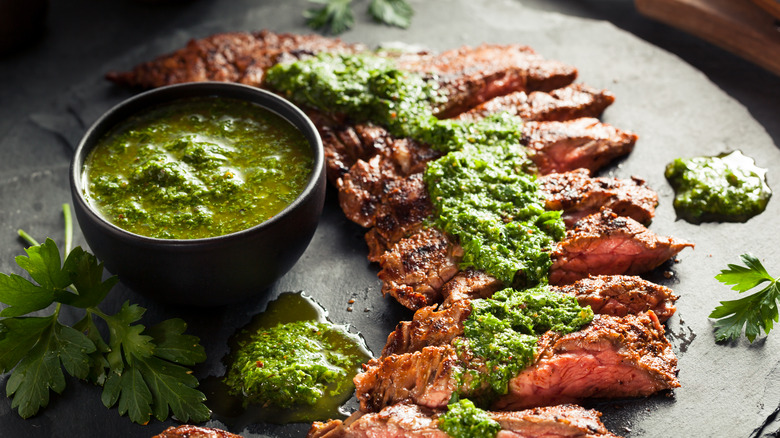The Zesty Difference Between Chimichurri And Gremolata
Whether you've seen them on a restaurant menu, encountered them in the prepared foods section of your grocery store, or made them at home, chimichurri and gremolata are two undeniably delicious condiments. They add a zippy boost of flavor and freshness to savory dishes — meat, fish, carbs, and vegetables — and their simple ingredient lists make them easy to whip up at a moment's notice. Plus, you can make them up to a few days ahead of time, so you don't have to worry about chopping bunches of herbs at the last minute just to enjoy their fresh flavors.
While chimichurri and gremolata share some key ingredients, they're also different in important ways. For one, chimichurri comes from Argentina, and gremolata from Italy. While both include parsley and garlic, their other ingredients impart distinct tastes and textures — gremolata has lemon zest and chimichurri gets its acidity from vinegar. And while chimichurri incorporates olive oil and vinegar, gremolata does not, so it's dry. Both chimichurri and gremolata will serve your cooking well, so to understand how to make the most of them, take a look at what makes each one special.
Their origins and ingredients
Chimichurri originated in Argentina, a country where beef is an extremely popular food. In Argentina, chimichurri is frequently served with steak as a sauce that can be drizzled on top just before eating, or used as a marinade to tenderize a cut of meat while also adding flavor. A simple chimichurri recipe is made with parsley, olive oil, red wine vinegar, garlic, shallot, red pepper flakes, and salt and pepper, which combine into a spreadable paste or sauce. You can adjust these proportions to customize your chimichurri — whether your prefer it to be more vinegary or more garlicky — and it's common to find regional recipe variations around Argentina.
Gremolata is from Italy, and like chimichurri, it's served on top of meat, as well as fish and vegetables, to provide some brightness and freshness. A gremolata recipe has a much shorter ingredient list — it only requires parsley, garlic, and lemon zest — although you can add salt, pepper, and other flavorings depending on your preferences. A big difference here is the absence of oil, as gremolata doesn't have any olive oil and chimichurri does. This makes gremolata less of a condiment-style sauce and more along the lines of a flavor-enhancing garnish.
Preparing and enjoying these savory toppings
Both chimichurri and gremolata can be made without any specialized equipment. In fact, if you were planning to break out the food processor for either of these, you're better off leaving it on the shelf. The parsley leaves that are central to chimichurri and gremolata can become bruised by a food processor's blade, which causes them to release too much water. For the best results, chop your herbs with a knife and use other manual tools (either a knife or grater) for the garlic, shallot, and lemon zest, then combine everything together with a fork.
Chimichurri will quickly make a simple piece of grilled fish, chicken, pork, or steak taste more complex and interesting. All you have to do is spoon it over the top. You can also serve some on the side in a small dish for dipping bread throughout the meal. Try it on eggs or as a burger condiment, too — its bright flavor profile is a welcome addition at breakfast, lunch, and dinner.
Gremolata has more of a distinct tang to it than chimichurri, thanks to the addition of lemon zest, which makes it great for balancing out rich foods. Traditionally, it goes on top of hearty dishes such as braised meat. If you add toasted breadcrumbs, you can also sprinkle it on top of a cheesy pasta dish to add an unexpected flavor enhancement.


